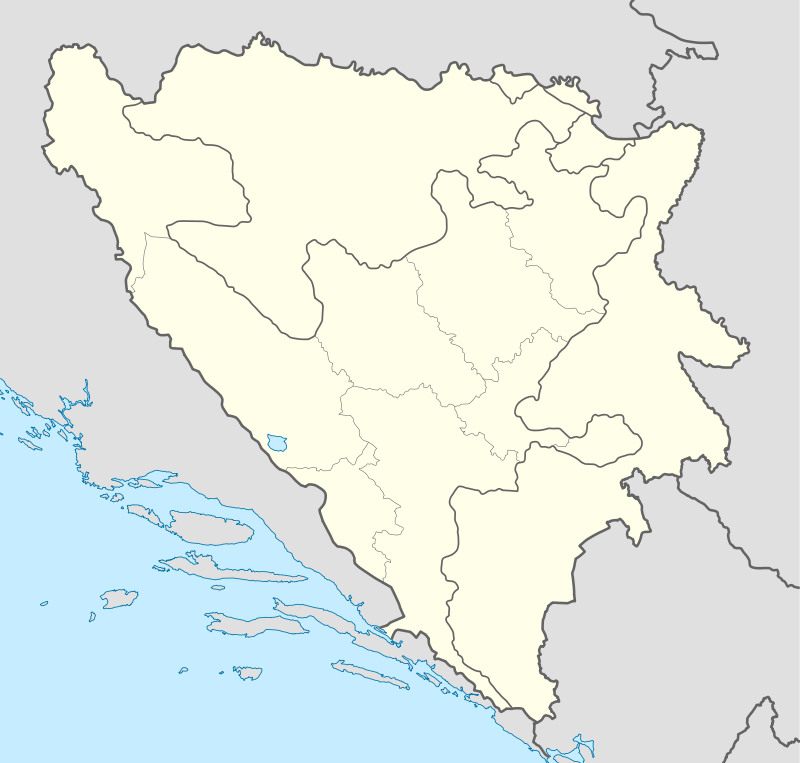Stopan
| Stopan | |
|---|---|
| Village | |
 Stopan Location in Bosnia and Herzegovina | |
| Coordinates: 44°29′02″N 17°33′49″E / 44.4839°N 17.5636°E | |
| Country | Bosnia and Herzegovina |
| Entity | Republika Srpska |
| Municipality | Kotor Varoš |
| Highest elevation | 680 m (2,230 ft) |
| Lowest elevation | 660 m (2,170 ft) |
| Population (1991) | |
| • Total | 346 |
Stopan (Serbian Cyrillic: Стопан) is a village in the Bosnia and Herzegovina, Kotor Varoš Municipality, Šiprage local community. At the census in 1991, Stopan had a population of 346 inhabitants. According to preliminary results of the census 2013 there were 119 citizens.[1]
Geography
Stopan is located on the pass - hill (altitude about 680 m) sandwiched between Crkvenica and Stopanski river – right tributaries of Vrbanja river. From this village to Šiprage there is (mostly gravel) local road, length of about 8 km. [2][3][4]
Stopan used to be a relatively big village of opportunities Šiprage's area, rich of drinking water and widely known orchards, domestic fruit products and hospitality.
History
During World War II, this village took part in the defense forces and was significant partisan jump refuge. Among others, January 1944 has received a large number of wounded partisans, who were evacuated from the Divisional Hospital in gorge of Demićka (nearby of Šiprage), during Sixth enemy offensive. Because of the distance of the main local communications, Stopan is, and when other hostile penetration, was a safer refuge for the civil inhabitants of surrounding localities.[5]
During the War in Bosnia (1992-1995), Army , police and paramilitary forces of the Republika Srpska destroyed the surrounding Bosniak villages, especially those upstream of Vrbanja to Kruševo Brdo as well as those downstream to Banja Luka.[6][7][8]Local inhabitants were being killed, and the majority was expelled. After 1996, most Bosniak villages in Šiprage community were partly restored, thanks to the BELUGA batallion of the EUFOR-SFOR Mission.[9] Only mosque in wide area is renewed.[10]
Population
| Stopan[11][12] | ||||||
| Census Year | 1991. | 1981. | 1971. | |||
| Bosniaks | 211 (60.98%) | 177 (46.46%) | 194 (47.67%) | |||
| Serbs | 133 (38.44%) | 174 (45.67%) | 204 (50.12%) | |||
| Croats | 1 (0.29%) | 1 (0.26%) | 1 (0.25) | |||
| Yugoslavians | 29 (7.61) | |||||
| Slovenians | 2 (0.49) | |||||
| Other and Unknown | 1 (0.29%) | 6 (1.47%) | ||||
| Total | 346 | 381 | 407 | |||
References
- ↑ "Općina Kotor Varoš". nasbih.com.
- ↑ Vojnogeografski institut, Izd. (1961): Šiprage (List karte 1:25,000 - Izohipse na 10 m). Vojnogeografski institut, Beograd.
- ↑ Spahić M. et al. (2000): Bosna i Hercegovina (1:250.000). Izdavačko preduzeće „Sejtarija“, Sarajevo.
- ↑ Mučibabić B., Ur. (1998): Geografski atlas Bosne i Hercegovine. Geodetski zavod BiH, Sarajevo, ISBN 9958-766-00-0.
- ↑ Samardžija S. (1983): Četrnaesta srednjobosanska NOU brigada. Skupština opštine Prnjavor, Banja Luka.
- ↑ Gutman R. (1993): A witness to genocide: The 1993 Pulitzer Prize-Winning Dispatches on the "Ethnic Cleansing" of Bosnia. Macmillan Publishing Company, Inc., New York, ISBN 9780020329954, pp 150-175.
- ↑ Beč J. (1997): Pucanje duše. Samizdat B92, Beograd, ISBN 86-7208-010-6.
- ↑ http://www.slobodnaevropa.org/a/negiranje-genocida-ne-menja-cinjenice/27423754.
- ↑
- ↑
- ↑ Book: "Nacionalni sastav stanovništva – Rezultati za Republiku po opštinama i naseljenim mjestima 1991.", statistički bilten br. 234, Izdanje Državnog zavoda za statistiku Republike Bosne i Hercegovine, Sarajevo.
- ↑ Internet – Source: "Popis po mjesnim zajednicama" – http://www.fzs.ba/Podaci/nacion%20po%20mjesnim.pdf
Coordinates: 44°29′02″N 17°33′49″E / 44.4839°N 17.5636°E